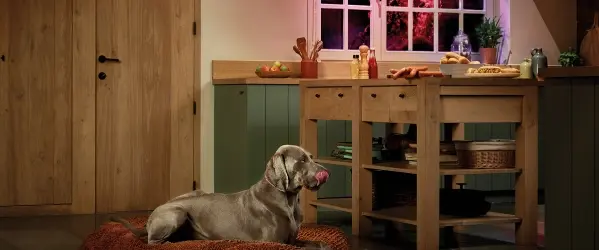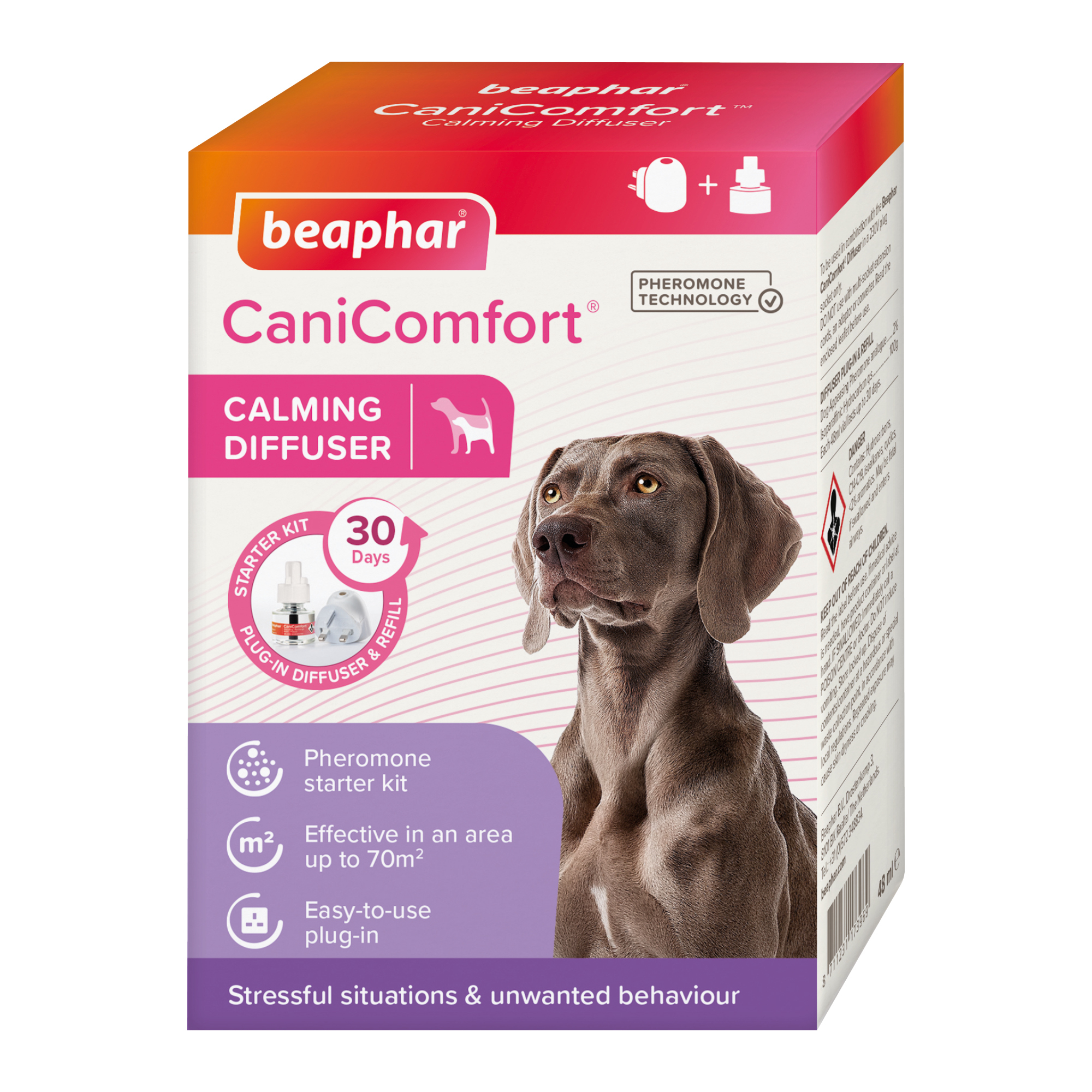Fireworks and bonfire night - a step-by-step plan for your pet
Fireworks and bonfire night celebrations are usually an exciting time for us, but can be a source of stress for our pets. Research from the RSPCA shows 54% of cats and 62% of dogs show signs of distress when they hear fireworks, so it’s important we do everything we can to help them feel calm and reassured during this stressful time.
With multiple fireworks going off in the days leading up to and following November 5th, this could lead to greater feelings of stress or anxiety for our pets, so it’s important to know how help calm them.
How can I calm my cat or dog during fireworks?
There are several things you can do to help calm your cat or dog if they’re scared of fireworks. Closing the curtains, turning up the TV volume or putting music on can all help drown out the noise and light from fireworks, and help calm your cat or dog down. If your pet goes off to hide, that’s okay too and you should let them do so (providing they aren’t hiding somewhere they could be hurt).
But, the best thing you can do to help keep your cat or dog calm during fireworks is to make sure you’re prepared before fireworks start going off. To help you out, we’ve created this step-by-step guide so you and your pet can be fireworks ready.
How do I prepare my cat or dog for fireworks?
Our cats and dogs will never be completely prepared for fireworks, but there are things you can do and steps you can take to help them get through it.
- Find out when fireworks or Bonfire Night events are happening in your area
- Make sure your pet’s microchip and collar information is up-to-date
- Create a den where your pet can hide during fireworks
- Prepare your pet for fireworks
- Feed and walk pets before fireworks start
- Secure the house
- Create a distraction from the fireworks with the TV or music
- Act natural
Step one: Research fireworks and bonfire night events in your area
Check online or keep an eye on social media to see if there are any large bonfire and firework celebrations planned in your area. If you’re friendly with your neighbours, pop a note through their door asking if they’re planning on setting off fireworks.
Knowing these details means you can plan ahead for your pet, and help reduce any stress your cat or dog may experience from fireworks.
Step two: Check your pet’s microchip and collar information is up to date
As owners, we'll do all we can to make sure our pets don’t get scared and run off during fireworks. But, if they do you’ll want to make sure you are reunited with them as quickly as possible.
When in a public place, all dogs must wear a collar with their owner’s name and address on, so make sure this is correct too. It’s also a legal requirement for all cats and dogs to be microchipped. To remain compliant your contact details must be up-to-date.
For more information about microchipping, you can visit these helpful links:
Microchipping Your Pet - How It Works | RSPCA - RSPCA - rspca.org.uk
Dog Microchipping Questions & Answers | Dog Advice | Dogs Trust
Step three: Create a pet den where your cat or dog can hide during fireworks
Fireworks can last a long time, and one of your pet’s reactions to fireworks could be to run and hide. As you don’t know how long your cat or dog will hide, you want your pet to be as comfortable as possible.
Your cat or dog may retreat to a place in your home that feels familiar and safe. If they already have a favourite place or ‘safe zone’, try to make it more firework proof and create a pet den.
How to make a firework den for your cat or dog
- Find a place or room where your cat or dog usually spends most of their time.
- Use a duvet or blankets to cover your pet’s den or create the roof. The thick material helps muffle the sound of fireworks. Pegs can be useful for keeping them in place.
- Add some clothing that smells of you to help soothe your pet and some extra bedding to make the space even more cosy.
- Place some toys and treats inside. This will help your cat or dog create a positive association with the den, and they will feel happier being there. For cats, you can use Beaphar StressLess Herbal Calming Cat Treats, which will provide additional calming support.
- To provide additional reassurance, you could also use a calming diffuser in the den or room. Just plug in the diffuser around a week before you expect fireworks. You can choose from:
- Beaphar CatComfort® or CaniComfort® pheromone calming diffusers that promote feelings of reassurance for up to 30 days
- Beaphar StressLess, a herbal calming diffuser that uses soothing Valerian and Lavandin to calm for up to 4 weeks
Step four: Prepare your pet for fireworks
Around late October, play some firework sounds in your house. Don’t turn the volume up high, but do make sure your cat or dog can hear it. Once they are comfortable with the noise level, you can gradually begin to increase the volume each time you play the sounds as long as your pet is not showing signs of stress.
This will help them to get used to the noise, so when fireworks start going off in the days leading up to and following November 5th your pet is more accustomed to the noise.
The Dog’s Trust’s ‘Sounds Scary’ programme has been created specially to help cats and dogs with a fear of fireworks, and can be downloaded for use at home. Click the link to find out more.
Shortly before the fireworks season start, fit a calming collar or apply spot-on to your cat or dog. These types of calming products produce a calming effect that travels with your pet, so are ideal for using a few days before to keep you covered when fireworks start going off.
For cats, choose from:
Beaphar CatComfort® Pheromone Calming Spot-On – begins working within 15 minutes of application and calms for up to 1 week.
Beaphar StressLess Herbal Calming Spot-On – begins working around 1 hour after application and calms for up to 1 week.
Beaphar StressLess Herbal Calming Collar – begins working around 1 hour after fitting and calms for up to 6 weeks.
For dogs, choose from:
Beaphar CaniComfort® Pheromone Calming Spot-On – begins working within 15 minutes of application and calms for up to 1 week.
Beaphar StressLess Herbal Calming Spot-On – begins working around 1 hour after application and calms for up to 1 week.
Beaphar CaniComfort® Pheromone Calming Collar – begins working within 15 minutes after fitting and calms for up to 4 weeks. Available for adult dogs and puppies. Puppy size also available.
Beaphar StressLess Herbal Calming Collar – begins working around 1 hour after fitting and calms for up to 6 weeks.
Step five: Feed and walk pets before fireworks start
If your cat or dog’s feeding time coincides with when the fireworks go off, feed them earlier. Once the fireworks start your pet could become too stressed to eat.
Try to take dogs for a walk during the day or earlier in the evening before fireworks normally begin. If your cat goes out during the day, consider closing the cat flap earlier than usual so they are not outside when it starts getting dark and fireworks are let off. If they stay out for long periods of time or are hard to tempt inside, you can keep cats indoors all day.
Although keeping your cat indoors for a long period of time may not be a viable option, you could try to alter their feeding times to encourage them to come earlier in the afternoon, so you can then keep then indoors overnight.
Step six: Secure the house
Once your pet is inside the house, double check you’ve locked your windows, doors and cat/dog flaps. Cats and dogs may try to run away if they’re scared of the noise and light of the fireworks. If they end up outside, they could be in an even scarier or more stressful situation, and are more likely to run away and get lost.
Step seven: Create a distraction from the fireworks with the TV or music
Close the curtains, particularly in the room in which you’ve built your pet den, to block out the noise and light from the fireworks. Put on some music or turn your television up a little louder than normal to help muffle the sounds. Having some of your pet’s favourite toys lying around will help them focus on another activity rather than the firework noise.
Step eight: Act natural
In the same way that children look to their parents and take cues from them, your pet will too. If you don’t seem bothered by the noise, then your cat or dog is more likely to feel relaxed too. Keep a supply of food or treats your cat or dog loves so you can reward good and calm behaviour.
Can I use a calming aid to keep my cat or dog calm during fireworks?
Calming products are ideal for supporting cats and dogs during stressful situations, such as fireworks and bonfire night. You can choose from pheromone calming or herbal calming products.
Pheromone calming products, such as Beaphar CatComfort® and CaniComfort® calm pets without sedating, and are species-specific. For example, a cat pheromone product will only affect cats, but wouldn’t affect other pets or people in the home. Certain pheromones trigger an instinctive calming response, so using these pheromones in calming products is an easy and effective way to help pets feel calm and reassured during stressful situations.
Herbal calming products, such as Beaphar StressLess, uses plant-based ingredients, such as Valerian and Lavendar to help calm pets. The herbal ingredients are well-known for their calming properties and often used in human healthcare to manage stress and anxiety. The products are suitable for both cats and dogs, so are a great option for owners with multi-pet households.
At Beaphar, we have pheromone and herbal calming products available in a variety of formats, so you can easily find a suitable calming solution for your cat or dog.
At Beaphar, we have a range of pheromone calming products available
You can easily find a suitable calming solution for your cat or dog.As mentioned above, our Beaphar CatComfort® and CaniComfort® Calming Diffusers are ideal for plugging in the same room as your pet den. They release pheromones into the room for up to 30 days, helping your cat or dog feel comfortable and safe.
Alongside the calming diffuser, our Beaphar CatComfort® and Beaphar CaniComfort® Calming Spot-Ons create a calming effect that travels with your pet, helping reassure them wherever they go. The calming spot-ons begin working around 15 minutes after application and are effective for up to 1 week, so perfect for firework season when fireworks could be set off over several days.



